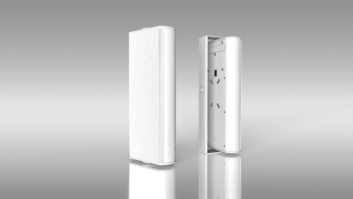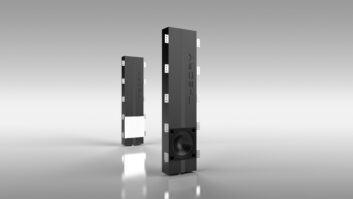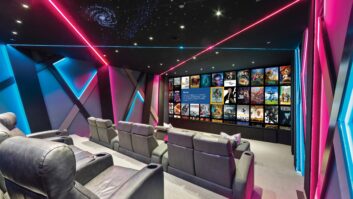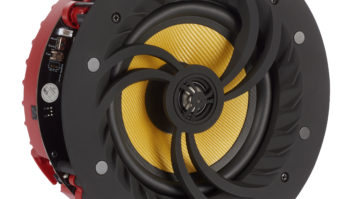Custom-install suppliers are flocking to CEDIA Expo with their first multi-room audio systems, expanded selections, or system upgrades, and they’re employing a variety of system architectures to distribute audio throughout the house.
Established custom companies launched their first multi-room audio systems include speaker brand Proficient, home automation supplier Home Automation Inc. (HAI), and startup ACX, which is launching a system that distributes audio and control signals in the Internet Protocol over Ethernet networks.
Companies upgrading their IP-based systems include Colorado vNet and Netstreams, who build their amplifiers into local in-wall keypads or touchscreens.
Russound and Oxmoor are two other companies that have adopted local amplification, or placing amplifiers in the same room as the in-wall and in-ceiling speakers that they amplify. The two companies are also expanding their multi-room selections.
More traditional system architecture places whole-house amplification in a central location. Elan, for example, is launching what it calls the industry’s smart speaker selector, which is positioned next to a central amplifier. Home Automation Inc. also uses centralized amplifiers in its first multi-room system. (See facing page.) Ironically, that system allows installers to plug source units into these systems from any room in the house, not just from a central stack of A/V components.
In other multi-room developments, Russound and Harman Kardon are showing the first A-BUS systems to use digital amplifiers in their amplifier/keypads to boost output, replacing analog amplifiers.
Meantime, companies such as Crestron and Convergent are offering new touch screens that integrate the control of other-brand multi-room audio systems and other home subsystems, such as lighting.
Here are some of the systems that installers will hear at the Expo:
ACX: Startup Automated Control Networx (ACX) is launching a system that distributes music and control signals over an IP/Ethernet network. The system includes the Alexis ALX-G1 Integrated Network Spyder, a pre-configured Intranet server preprogrammed to automatically recognize select source components without additional programming or installation of drivers.
The distributed audio system can be controlled by a desktop computer, laptop, or tablet PC.
“With our solution, all the installer has to do is attach the cables from the target components to the ALX-G1, then attach the network, plug it in, and they’re done,” claimed VP Jatin Desai. “Configuration is 100 percent automatic.”
One of the first components for which the Alexis is preprogrammed is Antex’s satellite radio triple tuner. When connected to an ACX system, the triple tuner delivers a live-channel preview capability, allowing users to see what’s playing on other XM or Sirius channels while listening to a stream.
The feature, available only through the ACX system, “builds the entire satellite channel listing (both XM and Sirius) dynamically and is updated every two minutes, never requiring manual editing,” Desai said.
ELAN: The Playroom series of “smart” speaker selectors is said to bring the features of more expensive multi-amplifier, keypad-type multi-room systems down to more affordable levels.
They are smart enough to dynamically adjust impedance according to the number of speakers playing and the volume they’re playing at, ensuring that all speakers receive maximum power at all times and that the connected two-channel amplifier never operates below its nominal impedance rating, the company said.
Dynamic Power Distribution (DPD) circuitry, the company explained, uses easily-configured dip switches that let installers define the impedance of the speakers connected to it and the impedance rating of the receiver or amplifier being used. DPD circuitry then detects the number of speakers active at any given time and dynamically adjusts the impedance settings as users turn the volume up or down.
They are also is smart enough to fire up preprogrammed groups of speakers at pre-selected volume levels in different rooms simultaneously in much the same way that lighting systems light up scenes.
They’re also IR-controllable from a consumer’s own handheld IR remote in remote rooms via IR sensors that allow for pass-thru IR control of other stereo components. Consumers can use their favorite learning remote to turn music on or off and adjust the volume in each room, independently. An included IR remote can be used to “teach” discrete, room-specific commands to the user’s favorite learning remotes.
PlayRoom Intelligent Speaker Selectors are available in 2-, 4- and 6-room models at a suggested $299, $499 and $699. They’re targeted to ship in the first quarter.
Harman Kardon: In expanding its A-BUS selection, the company is unveiling its $249-suggested AB 2 in-wall keypad/amplifier and new $599 ABH 4000 expansion hub, which distributes stereo audio, power and control signals from up to four audio sources to up to eight rooms in four zones.
They’re due in November.
A-BUS technology, developed by Australia’s LesiureTech, sends analog audio, control signals, and low-voltage power over separate conductors on a single CAT-5 cable to simplify wire runs and reduce signal losses caused by long runs of speaker-level cable.
The AB 2 is the first A-BUS keypad offered by Harman Kardon that enables source selection as well as source control directly from the keypad. An existing AB 1 keypad delivers source selection only through a built-in IR sensor and handheld IR remote.
The AB2 keypad, which can be used with any A-BUS products, includes buttons to select any of four source components and to control their volume and other functions. It fits into a standard electrical J-Box and includes integrated IR sensor that relays commands from Harman Kardon Zone II handheld remotes to a source component.
The ABH 4000 provides a cost-effective way to create a four-zone audio system using only source components and A-BUS keypads such as the AB 2 and existing AB 1, which incorporates an analog amplifier and only controls the volume of one source without providing source selection. Multiple ABH 4000s can be cascaded to distribute audio to more zones.
The ABH 4000 also adds A-BUS multi-zone functionality to any audio/video or stereo receiver, and it expands the A-BUS capabilities of Harman Kardon’s A-BUS/READY multi-room receivers.
The ABH 4000 includes four pairs of RCA stereo audio inputs that accept the audio output from up to four program sources. Its four IR emitter outputs enable control of connected source components.
When connected to select Harman Kardon A-BUS/READY and XM-ready multi-room receivers, it will deliver AM/FM and XM satellite programs throughout the house as well as iPod-stored music connected to the receiver via HK’s Bridge iPod docking station.
Proficient: The six-year-old speaker brand, part of the Linear family of brands, is expanding into multi-room audio systems for the first time with the launch of its Profient Electronic Series, due in September.
The value-oriented series launches with the M4 controller/amplifier, which is packaged with four single-gang in-wall keypads with built-in IR receivers and with IR repeater system at a suggested $2,000. It creates a six-source, four-zone multi-room audio system when connected to legacy sources. The M4 incorporates four-zone 8×30-watt digital amp and is expandable to 16 zones.
Also new: the M3 subwoofer amp/crossover, intended for use with an in-wall powered subwoofer when it ships in the fourth quarter.
Oxmoor: This company is expanding its ZON selection of multi-room audio systems to three from one with the launch of the starting-price ZAS-130 and mid-priced ZAS-430.
All three systems send digital audio data, control signals, and power over CAT-5e and CAT-6 structured wiring from a central A/V router to in-wall controllers with built-in digital amps. Like powerline-network technologies, ZON systems send audio and control signals over the same conductors as power. The architecture is meant to simplify wire runs and eliminate the signal loss and noise inherent in systems that distribute speaker- or line-level audio signals around the house in analog form.
The four-zone ZAS-430 system, at $1,999, includes one router connectable to two audio sources, one in-wall remote source-input module to connect sources in other rooms to the ZON network, four in-wall 2×15-watt controller/amplifiers, and one system remote control. The 430 accepts an additional in-wall input module to expand the system to four sources, and stacking additional routers expands the number of controllable sources even more.
The ZAS-130 at $1,199 is a single-source system packaged with four single-gang 2×15-watt controller/amplifiers, one 6×6-inch router small enough to fit inside a structured-wiring cabinet, one in-wall input module and one remote control. It ships in late summer, followed by the ZAS-430 in early fall.
The top-end ZON system sells for around $3,999 and accepts up to nine sources.
Russound: The company is stepping up the capabilities of A-BUS multi-room systems with an in-wall keypad/amplifier that. For the first time in an A-BUS system, the system uses digital amplifiers to boost output, and it expands the number of sources and zones in an A-BUS system to six and eight, respectively, from four and four, respectively.
The products will be displayed as engineering prototypes for second-quarter availability. Pricing hasn’t been determined.
The new A-C68 rack-mountable controller, only 1U high at 1.75 inches, features a built-in library of IR codes to control IR-controlled sources, making it unnecessary to program individual keypads with codes. Additional codes can be learned. Up to six controllers can be stacked to create a 48-zone system.
A new single-gang keypad controller with LCD readout, the A-K5L, incorporates digital amp that more than doubles the power output of the company’s previous A-BUS systems with analog amps. The A-K5L features five-character LCD display and four buttons controls source selection, volume, bass, treble, volume, and special functions such as a party mode.
The companion A-KSC source-control keypad, which lacks amplifier and LCD, features 10 buttons that double as numeric buttons and transport controls.
Both keypads will be available in five colors.













